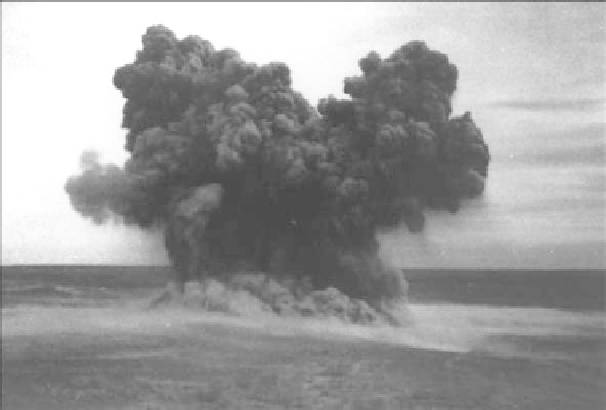Geology Reference
In-Depth Information
Figure 5.1.3. Controlled-directional blasting used to extinguish an underground coal-mine fire, Beishan coalfield,
Qitai County, China. Reproduced with permission of Taylor & Francis. After Bell and Donnelly 2006; photo by
Bell 1985.
Opencast Sites
At present, there is no completely reliable and successful method for the control and prevention of spontaneous
combustion of coal seams in opencast mines. However, in the Singrauli coalfield, India, the authors observed
combustion control using fire-prevention techniques (Bell and Donnelly, 2002, 2006). The techniques consisted of
the following procedures. Soon after stripping the overburden, the coal and associated rocks were cleaned using a
powerful water-jet hose. This served a dual purpose. The first was to remove any loose rock debris choking areas
where air would be trapped and the second was to cool the coal and nearby rocks. The coal and other rocks were
then sprayed with a liquid-bitumen-based compound that temporarily seals fissures where air could penetrate and
promote combustion. After about one year, the coal seam was extracted. This method has been used in India with
varying degrees of success. However, an adverse secondary effect of this technique is the generation of large
quantities of steam and ash, observed by one of the authors to present a nuisance to workers within the opencast
mine and surrounding areas (Figure 5.1.4).
Colliery Spoil Heaps
The spontaneous combustion of coal in colliery spoil heaps may be reduced if oxygen is prevented from mixing
with the waste and if there is an excess of moisture to contain any heating that may occur.
For spontaneous combustion to occur in colliery spoil, three things must be present. These are a substance with
sufficient calorific value to support combustion, a continual supply of air (oxygen), and a source of ignition. If one
or more of these are absent, then there is no potential for combustion to occur (Bell and Donnelly, 2006).
It was suggested by Cook (1990) that the emplacement of layers of compacted colliery discard on a spoil heap may
prevent or smother combustion by preventing air ingress. This blanketing technique, along with trenching, the
injection of non-combustible materials (e.g., pulverized fuel ash), and spraying with water potentially reduce the
risk of self-heating (Anon, 1973; Bell, 1996). Compacting with discard, although potentially effective in reducing
air flow into colliery spoil, must be done cautiously since this may induce collapse or subsidence if shallow voids
exist in the burnt spoil.
Temperature monitoring in boreholes may be used to verify and monitor the migration of a burning front within a
colliery spoil (Nottinghamshire, England example, below). Furthermore, loss-on-ignition tests may be undertaken
and compared with threshold limits (Richards et al., 1993). These range from 2MJ/kg (unlikely to burn) to 10MJ/kg
(almost certainly combustible) (Interdepartmental Committee on the Redevelopment of Contaminated Land
(ICRCL), 1986).

